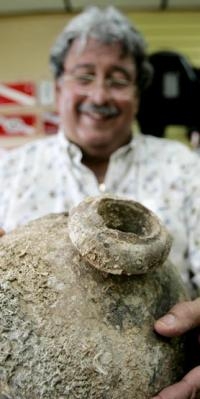Deep water treasure causes dispute between its discoverers and the government
Submitted on 2 September 2006 - 10:03pm
This article is reproduced by CienciaPR with permission from the original source.

By Ricardo Cortés Chico / end.rcortes@elnuevodia.com
endi.com
For the past 411 years, one of the greatest treasures in the history of the Caribbean, has been resting in the deep warm waters of the coast between Aguadilla and Isabela, and it is, perhaps, one of the best kept pirate secrets of the last fifteen years.
The treasure - considered by some to be valued in $900 million (sufficient to alleviate the fiscal crisis of the country) - consists of two English galleons located 157 feet-deep that contain “thousands” of archaeological devices that go from vases, military armament, to currencies in gold and silver.
Since 1991, the Institute of Puerto Rican Culture (ICP) knows of the existence of these boats.
However, its location is well-known only by a handful of people who integrate the Puerto Rican Academy of Professional Diving, in Isabela.
And although the Law of Protection, Conservation and Study of the Sites and Sub-aquatic Resources is quite flexible, so that the State could benefit from the sale of sub-aquatic deposits that it does not consider necessary, the conversations to recover the treasure are in a kinf of limbo because, according to the discoverer, Efraín Acevedo, the government refuses to share 50% of the treasure.
In fact, in case that the treasure is extracted, the governmental tendency is to conserve these objects by its historical value, explained Juan Vera, director of the Council of Sub-aquatic Archaeology; an independent organism presided over by the executive director of the ICP.
History of a finding
The main discoverer of the deposit, Efraín Acevedo, related that everything began in the 1991 when a fisherman of the area of Isabela took to his diving business what seemed to be pieces of and old vase.
Once the authenticity of the pieces, made between the 1580 and 1780, was confirmed, they dived in the area until finding the galleons.
“When we went, we found two galleons. The people from the academy discovered them. If it is what we think it is, the ship sunk in November of 1595. The boats are English because the devices of the ships are of English type”, he said.
The theory outlined by the group, in collaboration with several sub-aquatic archaeologists and historians, is that the ships belonged to the fleet of the legendary English pirate Francis Drake.
According to the investigation made by the discoverers, Drake stopped in “La Aguada” - the area whose location is thought to be between Aguada and Aguadilla- to re-supply of provisions after his failed attack to San Juan in November 23-24 of that year.
There, Drake and his men were surprised by Spanish soldiers, who fought Drake’s men to eventually destroy these two ships.
“This shipwreck happened when the ship where withdrawing, and happens at approximately 157 feet of depth. At that time, the Spanish realized it was impossible to go down that deep to recover the treasure”, he explained.
In fact, it was not until the decade of 1990 that the diving technology that allows to dive to extreme depths for long periods of time was commercially developed.
Struggle for the division of goods
Since 1997, Acevedo and its team have been trying to negotiate with the Council of Sub-aquatic Archaeology, the retrieval and conservation of the deposit.
“We have not had much cooperation from the government”, he said. “This is a national patrimony and they have the right to have it but as (the Puerto Rican Academy of Professional Diving) we are an educative organization and we have, by law, the right to obtain up to 50% of the existing treasure”, he commented.
The Law establishes that the State will never receive less than 50% of the market value of all the objects recovered in a sub-aquatic deposit, in cases where the discoverer is an educative organization or a museum.
On the other hand, Vera rejected the imputations about the lack of collaboration of the Council and indicated that the delays respond to that Acevedo has never presented a proposal for the excavation, study and preservation of the sub-aquatic deposit.
It confirmed that the organism knows about the sunken ships but that he is not conducting any investigation because he doesn’t know the exact location of the deposit and its historical and economic value.
Vera indicated that until Acevedo does not present the proposal, the Council will not be able to determine if they authorize the studies.
On the other hand, Acevedo reiterated that unless 50% of the value of the treasure is guaranteed to him he will not reveal the location nor he will present the proposal.







